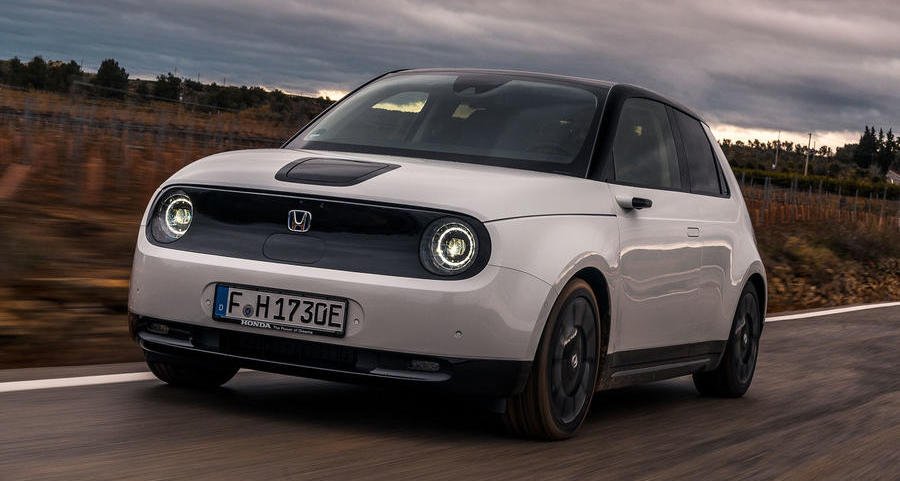What is it?
A theme common to many electric cars is that their weight and architecture lead to them feeling lead-footed and brittle. The Honda E has circumnavigated that issue. So, whatever else comes of this sub-supermini hatchback, attractive but not quite as pretty as the concept that preceded it, one of its plus points will be the way it drives.
Its new platform provides allround independent suspension with a MacPherson strut at each corner; dynamically, Honda has targeted much larger cars. For rolling comfort, smoothness and refinement, the E succeeds where others have not.
There is a catch, of course. This is a compact car – 3.9m long – that can be so only because it has a small energy store. While almost every manufacturer strives to fit a capacity of 60kWh or more (the Nissan Leaf e+ has 62kWh), the E has a liquid-cooled battery pack of just 35.5kWh between its axles. Resulting range, in 151bhp form, is a WLTP-certified 125 miles on 17in wheels or 137 miles on 16in wheels. And on our cold test day, it managed even less than that.
The E comes in two flavours: the regular 134bhp model and the 151bhp Advance tested here, which respectively cost a not-insignificant £26,160 and £28,660 after the plugin grant. Both can be slow-charged at a rate of up to 6.6kW or DC rapid-charged at up to 100kW, although a 50kW fill will be almost as quick – 31 minutes from 0-80%, rather than 30. It's like flying from Birmingham to Newcastle: no sooner than you're up to speed, it's time to wind down again.
What's it like?
The E's motor is at its rear, beneath a high boot floor, but any space that might have remained under the bonnet is taken up by an inverter and associated gubbins. This leaves the car short on space inside. Boot capacity is just 171 litres with the rear bench in place, while the back seats themselves don't give much leg room (there will be some leg-splaying for adult passengers) and the pair in the front are short of squab.
On the upside, all four seats, along with the rest of the trim, are really nicely finished. I'd happily have a waistcoat made from the tweedy-looking seat fabric, while there's some wood trim across a relatively flat dashboard that features a mix of retro-styled flatness and a broad array of digital screens.
Connectivity is one of the E's strong suits, says Honda. The thing is, how much do you need? There are two 12in screens in the centre and it's possible to 'pass' displays between them – if the driver wants to throw the sat-nav across for the front passenger to type in an address, say. But the resolution is fuzzy around the edges and there's smartphone mirroring, which is the most likely thing anyone will use anyway.
You can hook up a games console to the HDMI input if you want, plus there's a 240V power socket. You can even have a virtual aquarium to stare at while you're parked – which would probably have been more useful in the 1970s, when leaving kids outside the pub with a packet of crisps and a bottle of Coke was a thing.
Bordering these twin touchscreens and the digital instrument display are monitors in place of door mirrors. The small external cameras create less drag than mirror housings and the siting of the monitors is sensible. Finally, it's a mirrorless system that works properly; the lenses didn't attract any grime during our day of lousy weather and the view was always clear, even in dim conditions. Once you're used to these monitors, they contribute to an easy driving experience. Visibility is great and the progression of the controls, throttle and brakes is extremely smooth.
Plus, the push of a button activates a one-pedal driving mode, wherein throttle-off retardation is increased. Combined with slick medium-speed steering and a tight turning circle of 8.6 metres between kerbs, these qualities make the E a very good city car. On more open roads, its kerb weight of 1514kg (loads for a petrol small car but not for an EV) allows it to be gently sprung while retaining good body control. With 50/50 weight distribution, too, it's a really pleasingly balanced small car – not sporty but sophisticated, controlled and relaxed. Performance is moderate (0-62mph takes 8.3sec) but, with 232lb ft of torque available from rest, take-off feels, as is the EV way, much brisker than that.
Should I buy one?
Places where you stop and start frequently are where Honda reckons the E will find buyers: it's not for you if you want to go far, it admits. Most of the 200 UK deposits it has taken are from Greater London, where the ambitious asking price and limited range are presumably less of an issue.
Think of it as a smartphone rather than a tablet, says Honda, seemingly acknowledging that this is a car bought more with the heart than head. That's understandable, but it is a niche groove – easy to like but harder to recommend. If it had been made easier to recommend, though, maybe it would be harder to like.
Honda E specification
Where Madrid, Spain Price £28,660 (after government grant) On sale June Engine Electric motor Power 151bhp Torque 231lb ft Gearbox single-speed automatic Kerb weight 1514kg Top speed 90mph 0-62mph 8.3sec Range 137 miles (WLTP) CO2 0g/km Rivals Nissan Leaf, Renault Zoe
Related News



